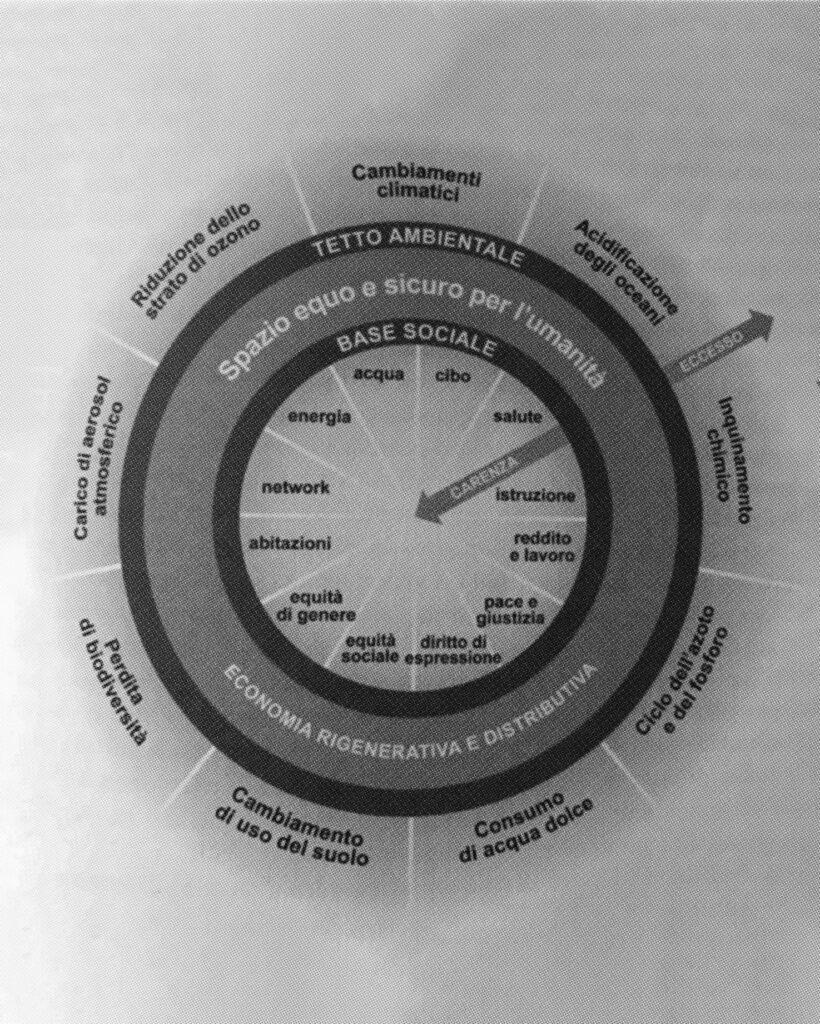“The core of a doughnut is a social foundation of welfare that no one should fall under and an ecological roof of global pressure that we should not exceed. There is a safe and fair space between the two“. Kate Raworth. (2017). Doughnut Economics.
Kate Raworth is an English ecological economist known for a new theory in the field of economic models, explained in her essay ‘Doughnut Economics: Seven Ways to Think Like a 21st-Century Economist‘ released in 2017. The theories explained in the essay challenge the widely accepted and standardized conception of economics, which is usually based on linear and infinite progress or growth, instead, this diagram has the shape of a disc with a hole in the middle →, in other words, a doughnut ↓.
The Doughnut Economics questions the foundations of the classical beliefs of economics, which are considered old, obsolete, and dangerous, as they are not updated, they do not take under seriously consideration the urgent issues of our times, such as climate change, biodiversity loss, pollution or massive production of waste. These critical issues are directly connected to the old system of beliefs and most are indeed caused by it. Typically, the negative aspects of the infinite growth model are downplayed or overlooked by most people, and finding new practical solutions is not a priority in the world of business. Meanwhile, the author of The Doughnut Economic suggests we should start to think outside the box, to conceive something different, something new, an economy that has in its core foundations not the will to make money or business as usual, but the will to live in a better world for everybody, moving into an integrated and conscious perspective.


The scheme consists of two rings, in the central one is enclosed “the social foundation” divided into twelve bases including food, water, and education,… while outside the “critical planetary degradation” is opposed through nine ecological limits present in natural systems. It is precisely between these two sets of limits that there is a space for humanity: a just, safe, and equitable area, in which society can position itself by developing an inclusive and sustainable economy. This mental model considers the economy prosperous not when it grows infinitely or is constantly increasing, but when all twelve social bases are met without exceeding any of the nine ecological ceilings, also setting itself the goal of ensuring, or curing, people’s fundamental rights. In other words, a safe and just space in which humanity, or perhaps life in general in its many forms, can prosper, or not be seriously jeopardized. A utopian space to aspire to, probably far-fetched or hard to put into practice, but as necessary as cultural baggage or theoretical thinking.
Furthermore
This dossier refers to the topic covered by the fourth and sixth virtuous design practices “Transformative drive from a proper intention” and “Collective attention with a proper effort” and aims at transforming inconsistent behaviors into something useful, extending its commitment to the community.
Articles covering the same topics
‣ The planet’s economist: has Kate Raworth found a model for sustainable living?, The Guardian, 2023.
‣ Kate Raworth: ‘a healthy economy should be planned to prosper, not to grow’. TED Conference, 2018.
‣ Rethinking the economy, stop the growth mantra. Here’s why a doughnut will save us, La Repubblica, 2017.